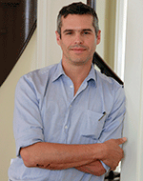The Ungerleider Palliative Care Lecture Series Presents: “Exploring the Aesthetic Dimensions of Palliative Care”

featuring BJ Miller, MD
By Jane Heisey
Dr. BJ Miller, MD is the Executive Director of the Zen Hospice Project in San Francisco and is recognized as a transformative thinker in the experience of end of life. Dr. Miller is also an Associate Director of the Symptom Management Service at the UCSF Helen Diller Family Comprehensive Cancer Center. He was recently featured as a 2015 TED Talk speaker in Vancouver, where he discussed reshaping death through “design thinking”.
As part of Ungerleider Palliative Care Lecture Series at California Pacific Medical Center, Dr. Miller spoke to an audience on May 19, 2015. In his talk, he encourages the front-line caregiver audience, predominately physicians and clinicians, to reframe their mindset regarding end of life patient care.
Palliative care is medical care for people with serious illness, providing relief from symptoms and suffering. The goal of care is improving quality of life for both the patient and the family. Here are the main points of Dr. Miller’s transformative talk.
- Miller covered various themes on living and dying to establish a background for the palliative aesthetic discussion. There is a fine line between living and dying for terminally ill patients; they are still living each day. Palliative care practitioners must try to balance between their own needs (self) and those of their patients (other) to avoid burnout. Discernment and judgement was another theme Dr. Miller explored. There’s nothing wrong with making distinctions so long as there’s no judgement, with respect to patients. Differences are what make us unique and interesting.
- Next, Dr. Miller segued into the topic of ATTENTION—how to remain present with our patients, despite it being a very immobile working state. For example the words being vs. doing: The fundamental tenant of palliative care is simply being present, rather than doing or “fixing” a patient. Being silent and present in the presence of suffering is so important but hardly something that is valued or rewarded in our culture. The same challenge exists for the patient—once the patient’s traditional role, i.e. as a parent, spouse, employee, etc. ends, many feel that they are just waiting to die.
- On Palliative Aesthetics: Art can communicate things that words cannot. The word aesthetic is typically associated with beauty but the aesthetic domain encompasses feeling, sensation, observation and overall perception. Anesthetize is to make numb, or the opposite of feeling, sensing.
- Several philosophers explored the idea of aesthetics: Kant described it as the free play of our cognitive powers, enlivenment, living fully and delved into how it can preserve the mind in calm contemplation. American philosopher John Dewey saw aesthetics in everyday things: sunsets, nature, and peacefulness. Circumstances that reward being present and intensifies the sense of immediate living is good. Think about the saying, “I could die today and be happy.”
- Miller displayed several photos of newly built European hospice architecture that reflects bringing outside aesthetics into view for the patients. These structures feature lovely visual design, beautiful settings, and lots of windows for a heightened sensory experience for patients.
In conclusion, incorporating aesthetic dimensions into palliative care treatment reframes the end of life experience not as a horrible death, but instead a melting or transitioning into the beautiful world around us.

